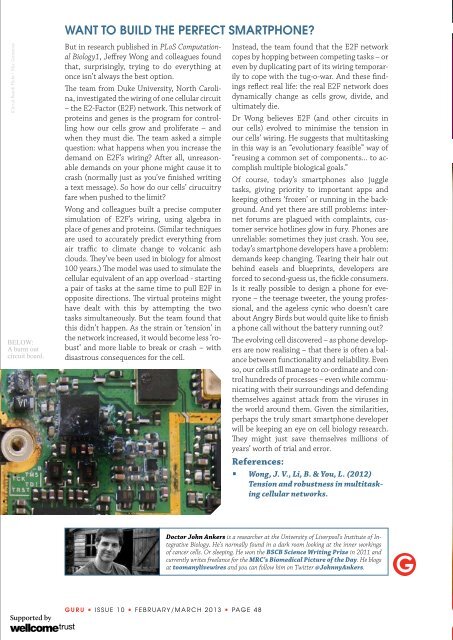Guru10-spreads
Guru10-spreads
Guru10-spreads
- No tags were found...
You also want an ePaper? Increase the reach of your titles
YUMPU automatically turns print PDFs into web optimized ePapers that Google loves.
(Circuit Board) Flickr • Mrs. Gemstone<br />
BELOW:<br />
A burnt out<br />
circuit board.<br />
WANT TO BUILD THE PERFECT SMARTPHONE?<br />
But in research published in PLoS Computational<br />
Biology1, Jeffrey Wong and colleagues found<br />
that, surprisingly, trying to do everything at<br />
once isn’t always the best option.<br />
The team from Duke University, North Carolina,<br />
investigated the wiring of one cellular circuit<br />
– the E2-Factor (E2F) network. This network of<br />
proteins and genes is the program for controlling<br />
how our cells grow and proliferate – and<br />
when they must die. The team asked a simple<br />
question: what happens when you increase the<br />
demand on E2F’s wiring? After all, unreasonable<br />
demands on your phone might cause it to<br />
crash (normally just as you’ve finished writing<br />
a text message). So how do our cells’ cirucuitry<br />
fare when pushed to the limit?<br />
Wong and colleagues built a precise computer<br />
simulation of E2F’s wiring, using algebra in<br />
place of genes and proteins. (Similar techniques<br />
are used to accurately predict everything from<br />
air traffic to climate change to volcanic ash<br />
clouds. They’ve been used in biology for almost<br />
100 years.) The model was used to simulate the<br />
cellular equivalent of an app overload - starting<br />
a pair of tasks at the same time to pull E2F in<br />
opposite directions. The virtual proteins might<br />
have dealt with this by attempting the two<br />
tasks simultaneously. But the team found that<br />
this didn’t happen. As the strain or ‘tension’ in<br />
the network increased, it would become less ‘robust’<br />
and more liable to break or crash – with<br />
disastrous consequences for the cell.<br />
GURU • ISSUE 10 • FEBRUARY/MARCH 2013 • PAGE 48<br />
Instead, the team found that the E2F network<br />
copes by hopping between competing tasks – or<br />
even by duplicating part of its wiring temporarily<br />
to cope with the tug-o-war. And these findings<br />
reflect real life: the real E2F network does<br />
dynamically change as cells grow, divide, and<br />
ultimately die.<br />
Dr Wong believes E2F (and other circuits in<br />
our cells) evolved to minimise the tension in<br />
our cells’ wiring. He suggests that multitasking<br />
in this way is an “evolutionary feasible” way of<br />
“reusing a common set of components... to accomplish<br />
multiple biological goals.”<br />
Of course, today’s smartphones also juggle<br />
tasks, giving priority to important apps and<br />
keeping others ‘frozen’ or running in the background.<br />
And yet there are still problems: internet<br />
forums are plagued with complaints, customer<br />
service hotlines glow in fury. Phones are<br />
unreliable: sometimes they just crash. You see,<br />
today’s smartphone developers have a problem:<br />
demands keep changing. Tearing their hair out<br />
behind easels and blueprints, developers are<br />
forced to second-guess us, the fickle consumers.<br />
Is it really possible to design a phone for everyone<br />
– the teenage tweeter, the young professional,<br />
and the ageless cynic who doesn’t care<br />
about Angry Birds but would quite like to finish<br />
a phone call without the battery running out?<br />
The evolving cell discovered – as phone developers<br />
are now realising – that there is often a balance<br />
between functionality and reliability. Even<br />
so, our cells still manage to co-ordinate and control<br />
hundreds of processes – even while communicating<br />
with their surroundings and defending<br />
themselves against attack from the viruses in<br />
the world around them. Given the similarities,<br />
perhaps the truly smart smartphone developer<br />
will be keeping an eye on cell biology research.<br />
They might just save themselves millions of<br />
years’ worth of trial and error.<br />
References:<br />
• Wong, J. V., Li, B. & You, L. (2012)<br />
Tension and robustness in multitasking<br />
cellular networks.<br />
Doctor John Ankers is a researcher at the University of Liverpool’s Institute of Integrative<br />
Biology. He’s normally found in a dark room looking at the inner workings<br />
of cancer cells. Or sleeping. He won the BSCB Science Writing Prize in 2011 and<br />
currently writes freelance for the MRC’s Biomedical Picture of the Day. He blogs<br />
at toomanylivewires and you can follow him on Twitter @JohnnyAnkers.<br />
#MIND<br />
ALICE IN WONDERLAND<br />
SYNDROME<br />
WHEN REALITY GOES DOWN THE RABBIT-HOLE<br />
KAT LOUGHEED


